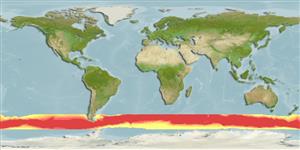>
Myctophiformes (Lanternfishes) >
Myctophidae (Lanternfishes) > Myctophinae
Etymology: Protomyctophum: Greek, pro = first, in front of + Greek, mykter, -eros = nose + Greek, ophys = serpent (Ref. 45335).
Environment: milieu / climate zone / depth range / distribution range
Écologie
marin bathypélagique; océanodrome (Ref. 51243); profondeur 50 - 332 m (Ref. 58018). Deep-water; 47°S - 65°S
Generally circumglobal between the Subtropical Convergence and the Antarctic Polar Front. Known from 53°18'S, 49°57'W and 51°05.5'S, 39°56.5'W in Atlantic Ocean sector, 47°S, 31°E and 49°S, 71°E in Indian Ocean sector, and between 60°-65°S, 70°-165°W in Pacific Ocean sector.
Taille / Poids / Âge
Maturity: Lm ? range ? - ? cm
Max length : 6.0 cm SL mâle / non sexé; (Ref. 5182)
Description synthétique
Clés d'identification | Morphologie | Morphométrie
Épines dorsales (Total) : 0; Rayons mous dorsaux (Total) : 13 - 14; Épines anales: 0; Rayons mous anaux: 22 - 25.
High-oceanic and mesopelagic (Ref. 4066). Found down to 200 m at night (Ref. 4066). Possibly fed on by Champsocephalus gunnari (Ref. 5182).
Life cycle and mating behavior
Maturities | Reproduction | Spawnings | Egg(s) | Fecundities | Larves
Hulley, P.A., 1990. Myctophidae. p. 146-178. In O. Gon and P.C. Heemstra (eds.) Fishes of the Southern Ocean. J.L.B. Smith Institute of Ichthyology, Grahamstown, South Africa. (Ref. 5182)
Statut dans la liste rouge de l'IUCN (Ref. 130435)
Menace pour l'homme
Harmless
Utilisations par l'homme
Pêcheries: sans intérêt
Outils
Articles particuliers
Télécharger en XML
Sources Internet
Estimates based on models
Preferred temperature (Ref.
123201): 0.2 - 6.3, mean 2.4 °C (based on 36 cells).
Phylogenetic diversity index (Ref.
82804): PD
50 = 0.5000 [Uniqueness, from 0.5 = low to 2.0 = high].
Bayesian length-weight: a=0.00871 (0.00387 - 0.01962), b=3.11 (2.92 - 3.30), in cm total length, based on LWR estimates for this (Sub)family-body shape (Ref.
93245).
Niveau trophique (Ref.
69278): 3.4 ±0.57 se; based on food items.
Résilience (Ref.
120179): Haut, temps minimum de doublement de population inférieur à 15 mois (Preliminary K or Fecundity.).
Fishing Vulnerability (Ref.
59153): Low vulnerability (10 of 100).
